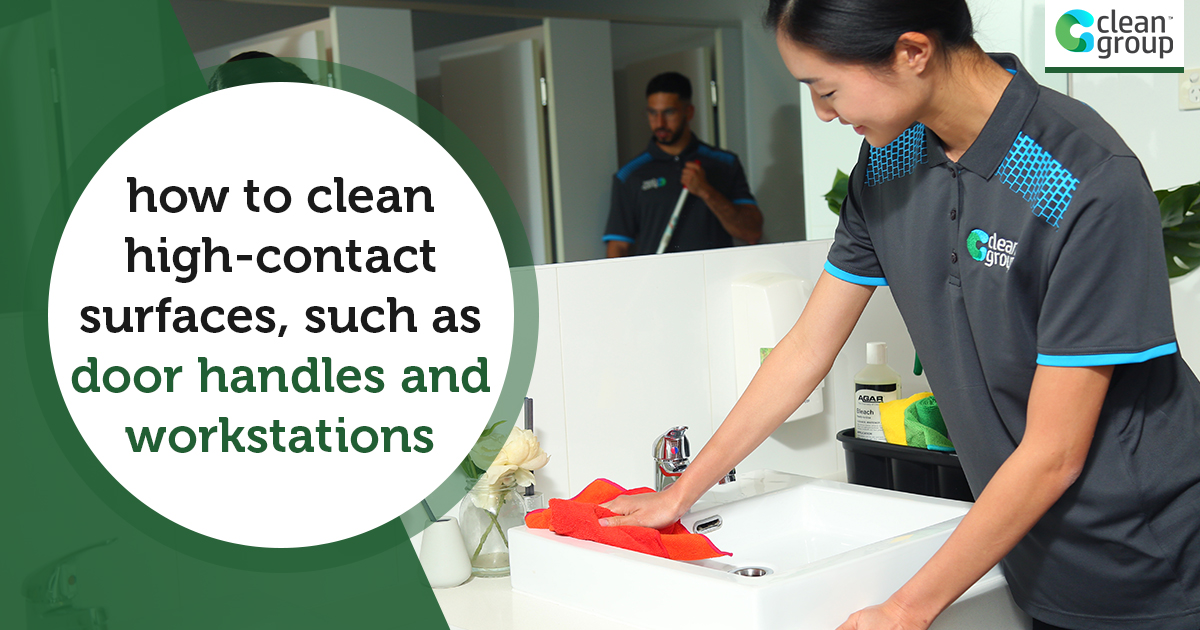This article is very timely. We will talk about the proper way of cleaning and disinfecting highest touchpoints in school, hospitals, workstations, childcare centres, restaurants and other crowded areas to stop the spread of viruses that can call illnesses.
Recently, there is a spread of a new virus called Novel Coronavirus. WHO already confirmed that the spread is worldwide.
As a business owner, you are always after the health of your customers and employees. Your number one priority is how will you be able to provide them with a safe place to their businesses.
There are plenty of ways on how you can secure safe working space for the people who rely on you. Be familiar with the high touchpoints and know how to clean it properly.
Last Update: 20th March 2030 – Coronavirus Cases in Australia: 785 | Deaths: 7 | Recovered: 46
Definition of High Touchpoints
These are surfaces or areas that have high contact with hands. These high touchpoints require recurring and persistent cleaning. Disinfection has to be observed at all times to kill and eliminate all harbouring germs and viruses. Some of the high touchpoints are light switches, door handles, faucets, keyboards, mouse, telephones, mobile phones, etc.
We all know that in the cleaning industry, a surface may look clean, but it is the unseen enemy that can harm or even kill us. We need to make sure that germs and bacteria are eliminated during the routine Sydney covid cleaning.
How To Address High Touchpoint Surfaces?
Surface Type
You need to know what type of material you are cleaning to use the proper cleaning chemicals. Use appropriate disinfectant so as not to damage the surface. Always read the label to learn how long you need the disinfectant to sit on an individual surface.
In an office set up, touchpoints are elevator buttons, common area telephones, restroom countertops, stair rails, doorknobs, and chairs in the reception area.
Please know that disinfectants target a specific virus or germs. You will need a broad-spectrum disinfectant to disinfect the surface successfully.
Surface Shape
Compare the surface of a table and a doorknob. The latter is more complicated than the first one. The doorknob has an irregular shape offering multiple points where bacteria can stay and multiply.
Bacteria double their numbers every half an hour. Specific types can live up to six to eight months on surfaces like phones, tablets, and doorknobs. Different tools should be used for hard to reach surfaces to address all germs and bacteria.
Know Your Cleaning Product
You should have known by now that reading label is a must in the cleaning industry. We need to use different chemicals and approach in eradicating bacteria and germs.
It is also imperative for you to follow the proper dwell time in utilising the disinfectant. You need to know the appropriate product to use.
Train Your Cleaner Well
Once you have developed a cleaning technique, you must make sure that all the cleaners who work for you know the method and best practices. You should develop a specific practice that everyone will follow.
This will also ensure that everyone is in line with the idea of getting rid of as many germs as possible.
Difference Between Cleaning, Sanitising and Disinfecting
Cleaning, disinfecting, and sanitising are not the same. It is essential to understand the differences between these three steps to expertly carry out your purpose.
Cleaning removes dust, dirt, grime, and some germs from surfaces or objects. Cleaning does not kill bacteria but lowers their numbers and makes it difficult for viruses to survive and multiply, reducing the risk of infection.
Continuous cleaning should be done in all commercial businesses. High touchpoints or areas that are touched frequently by many different people should be cleaned even more often.
- Touchpoints
- Door handles
- Hand railings
- Bathroom fixtures
- Shared desks
- Vending machines
- Shared keyboards
Using specific tools such as microfiber cloths and mops, high-efficiency filtration vacuums and steam cleaning machines can make help cleaning more effective.
A thorough ongoing cleaning program is significant in controlling the spread of infection. However, there are times when cleaning is just not enough. In most instances, cleaning should be done first, followed by either sanitising or disinfecting with the help of professional covid cleaners Sydney.
Sanitizing reduces germs on surfaces to a safe level to help decrease the risks of spreading infection. Sanitising is done through high heat or by using a sanitising product.
Disinfecting is more effective if the surface is clean first. Sanitising is required by regulation in food service areas and child care centres.
Disinfecting kills most germs on surfaces. The process of disinfecting does not leave a surface clean or removed bacteria which is why cleaning should be done first.
Disinfecting in schools are recommended for targeted use in high-risk areas and high-risk incidents.
High-risks areas pose a higher risk of transmitting infections and diseases. They include high touchpoints and other high-risk locations in the school environment.
High-risk areas also include any place where a high-risk incident occurs. High-risk incidents are accidents or events that include vomit, feces, blood, and other bodily fluids.
Certain situations require extra care, such as managing disease outbreaks and cleaning bodily fluids, vomit, and diarrhea. Vomit and diarrhea can transmit Norovirus, a highly contagious virus that is the most common cause of diarrhea and vomiting. During a Norovirus outbreak, disinfecting is critical.
When the incidence involves blood and other bodily fluids, staff should follow the disinfecting protocol outlined in the school or districts bloodborne pathogen training.
For safety reasons, whenever possible, a disinfectant should be used after regular hours when people are not present. Knowing how and when to clean, sanitised, or disinfect properly can help maintain a safe and healthy environment.
How to Disinfect Door Handles?
We all know that high touchpoints are breeding ground for germs and bacteria. Light switches and door handles are not an exception to this.
Many people use disinfecting wipes because it seems convenient. Disinfecting requires the spot to be wet at a specific timeframe, and it will be difficult for you to achieve this with disinfecting wipes.
You need to choose a fast-acting disinfectant that will help you disinfect hard to reach surfaces. Again, the surface has to remain wet during the dwelling period to properly disinfect.
Here are the steps on how to effectively disinfect door handles:
- Clean the door handle and remove dust and filth.
- Apply the disinfectant with hand pump trigger spray. Spray a liberal amount at least six to eight inches away from the surface
- Spray the disinfectant until the door handle is covered and wet.
- Allow sitting for two minutes
- Air dry or wipe with a clean cloth
How to Clean Your Frequently Touched Surfaces in Your Office
Employees stay in their respective workstations for at least eight hours a day. Keeping your workstation clean can help you eliminate germs and viruses that can cause illnesses.
Computer keyboard – based on studies, keyboards had more germs as compared to office toilets. Why? Professional commercial cleaners attend to the cleaning needs of the restroom regularly.
Whereas, your keyboard is lucky to have a wipe, maybe at least once a week.
Here Are Some Tips on Cleaning Your Keyboard:
- Unplug your keyboard
- Get a can of compressed air to blow off all the dust and debris seated at the bottom of the keyboard.
- Apply the disinfectant of your choice to a swab and wipe it in between keys
- Using a lint-free cloth, apply the disinfectant to the entire keyboard.
- Cleaning company owners are responsible for a clean and safe working space. They must protect their customers and the customers of their customers.
Telephone – whether you like it or not, your desk phone is a home for many germs and viruses. To clean it properly, you should:
- Unplug the phone
- Use a lint-free cloth with a cleaning solution and wipe all the surfaces carefully giving careful attention to the mouthpiece.
- After cleaning, get disinfecting wipes and wipe them all over the phone.
Computers – Once you are done with almost everything on your desk, you are now ready to clean your computer.
Follow these simple steps to get a clean, germ-free computer:
- Remove all the clutter from your desks
- Get a disinfecting wipe and clean all computer surfaces that you can touch and reach.
Working in a properly cleaned and sanitised work environment is imperative, whether you work in the food industry, a hospital, or a biomedical lab.
Keep in mind that particles left behind such as microbes or dust can easily transmit infections. When you need a safe work environment, do not simply wipe off a small surface on which to work.
Take the time not only to scrub down the area thoroughly but also to sanitise and disinfect every surface.
If you are using an industrial cleaning solution, make sure to prepare it directly before use. Avoid using towels, rags, or other cleaning implements that are visibly dirty. Change the cleaning solution regularly if you are using it for an extended period.
It is your cleaner’s job to ensure a safe and clean working environment. As an employee, it is also your primary duty to observe proper hygiene to stop the spread of these killer germs.
We want you to consider the points below and help you cleaner eradicate viruses from your workstation. Also, hygiene improves your productivity and well-being.
Make sure to do hand hygiene as often as you can. Cover your nose with a tissue or sleeves when coughing or sneezing. Make sure to clean and sanitise your workplace too.
Now that you have read some professional tips about cleaning doors, workstations, and frequently touchpoints. I want to know if you agree with all the facts that I mentioned in this article.
Please leave a comment below and share your tips and best practices in how you clean your high touchpoints.

